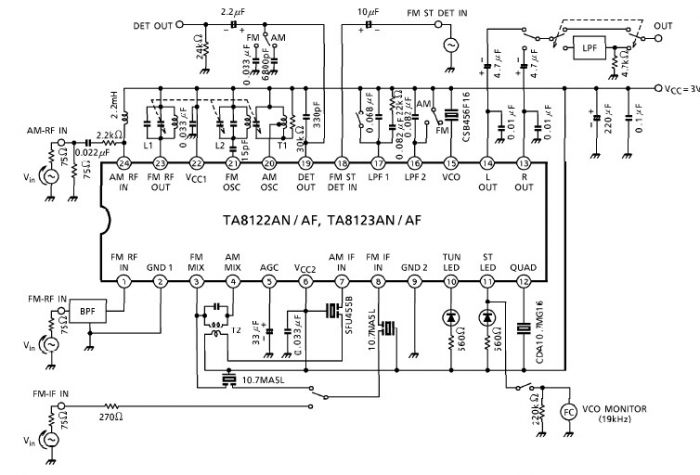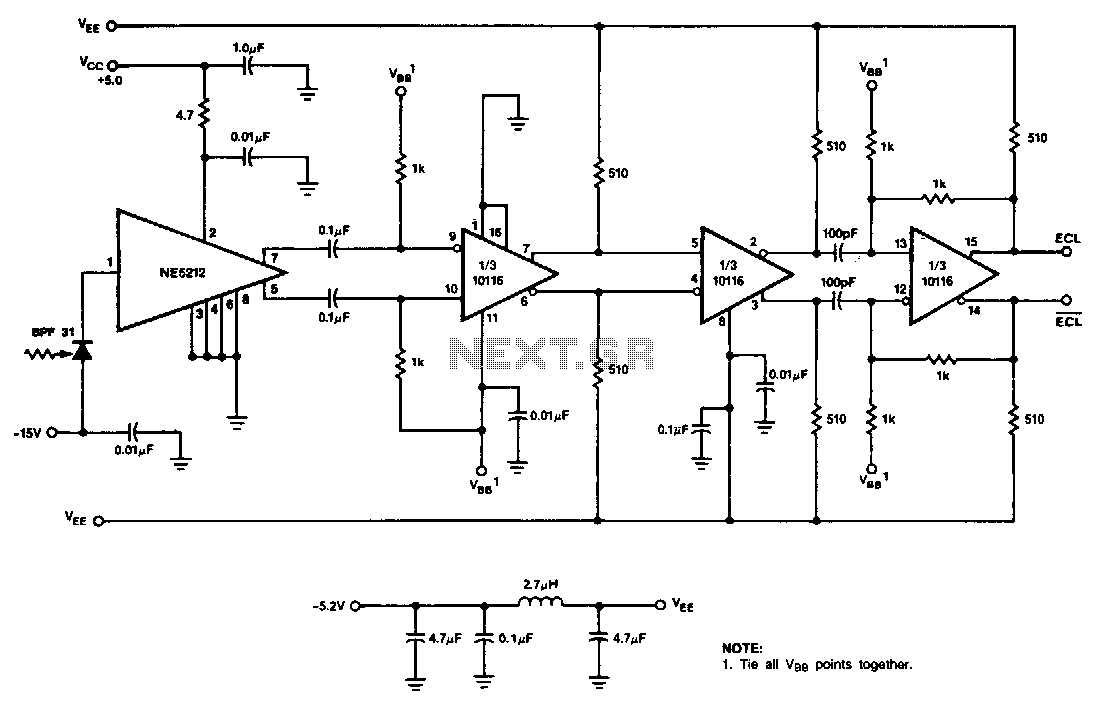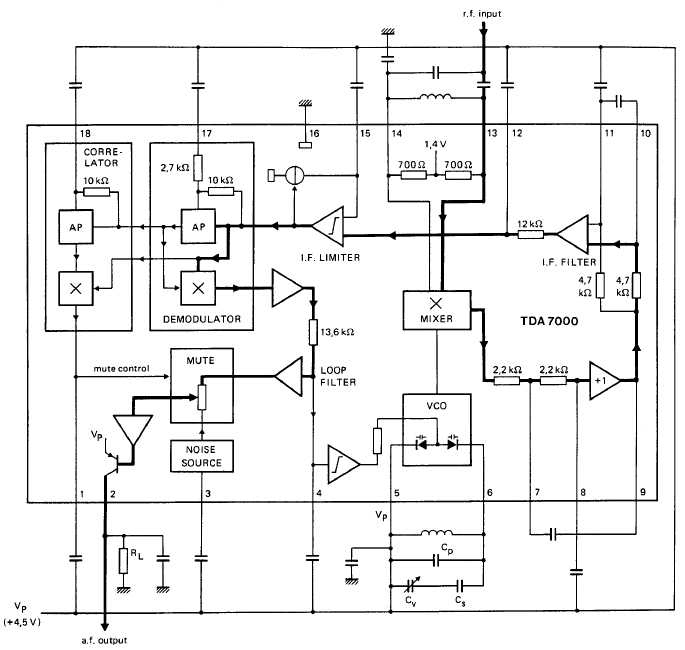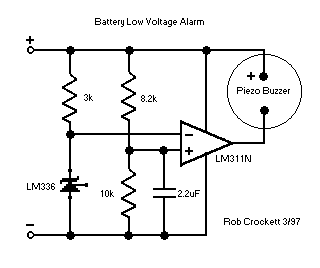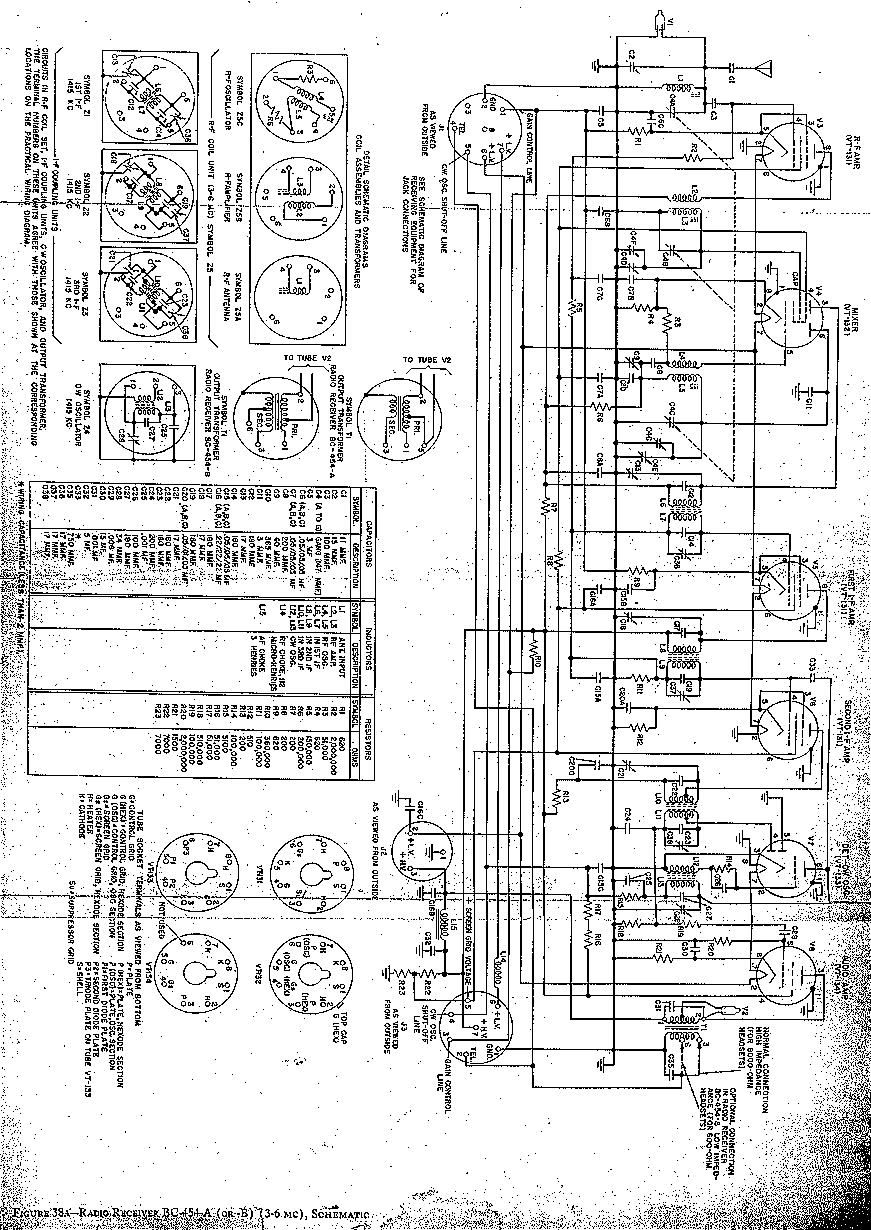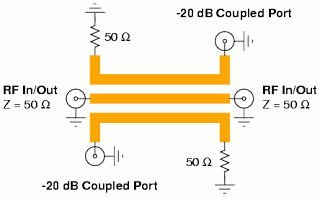
A 30 Mtr Direct Conversion Receiver for QRSS
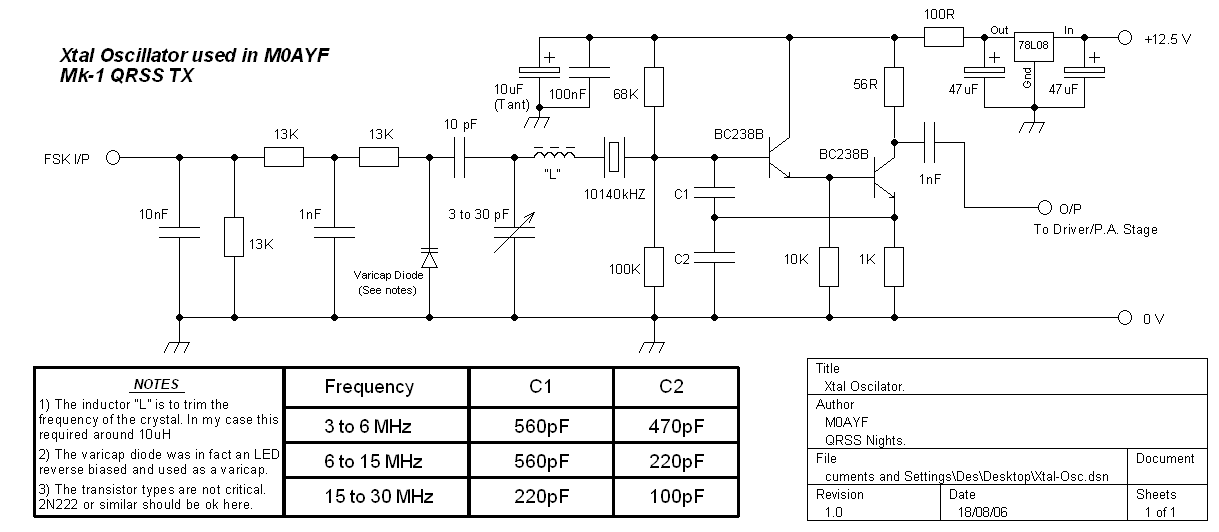
The schematic for the crystal bandpass filter/amplifier board is illustrated, along with images of the assembled and boxed unit. The signal frequency bandpass filter is constructed over a ground plane and enclosed in a separate housing measuring 75 x 75 x 50 mm to prevent unwanted signal leakage. This module also includes a small RF amplifier with modest gain to compensate for losses in the crystal filter. It is equipped with phono sockets for the antenna input and RF output. The RF output of the filter/amplifier module connects to the antenna input of the QRSS DC receiver. The module draws approximately 35 mA at 12.5 Volts, including the LEDs. Together, the direct conversion receiver and filter/amplifier modules create an efficient QRSS receiver, with potential performance improvements available through the addition of an AF Buffer Amplifier/AF Filter. This addition was aimed at enhancing performance under heavy QRM conditions, although the improvement was minimal. Evaluation of the unit suggested that using operational amplifiers with a lower noise figure could enhance performance. The AF filter is considered a worthwhile optional enhancement for managing QRM. The AF Buffer Amplifier/AF Filter was integrated into the receiver to prevent the software AGC in Argo from being affected by unwanted signals present in the audio passband of the DC-RX. These signals stem from other users on the 30-meter band, which can desensitize the receiver. Initially, a low-pass audio filter was contemplated; however, it was determined that an audio bandpass filter would provide superior performance without significant complexity. The low-frequency roll-off of the bandpass AF filter minimizes power line noise interference with the PC sound card and attenuates unwanted signals below the 100 Hz window used for QRSS. The original DC RX design may have lacked sufficient AF gain. While excessive gain can overload the sound card, a slight increase in audio gain could enhance sensitivity, as atmospheric noise was barely audible. The additional gain from a low-noise amplifier stage would elevate the wanted signal level above the noise level produced by the operational amplifiers in the active bandpass filter. A full schematic of the AF Buffer Amplifier/AF Filter is provided. The center frequency of the AF Filter is aligned with the QRSS sub-band as displayed in Argo and may require adjustment based on the crystal frequency used. Frequencies between 1 and 2 kHz are suitable for Argo. Fine-tuning of the AF filter can be achieved by adjusting two resistors (Rx2 and Rx3) in the circuit diagram, allowing stagger tuning of the two cascaded filter stages if a wider bandwidth is necessary. A "Q" of 8 is generally sufficient, as higher "Q" values may result in excessive ringing of the filter.
The crystal bandpass filter/amplifier board is designed to optimize signal processing in QRSS applications. The enclosure dimensions (75 x 75 x 50 mm) are strategically chosen to minimize external interference, ensuring that the filter operates with maximum efficiency. The RF amplifier included in the module compensates for the inherent losses in the crystal filter, maintaining signal integrity throughout the processing chain.
The connection scheme utilizes standard phono sockets for seamless integration with the QRSS DC receiver. The RF output is directly linked to the receiver's antenna input, facilitating the reception of weak signals while maintaining a low current draw of approximately 35 mA at 12.5 Volts, which is efficient for portable or battery-operated applications.
The introduction of the AF Buffer Amplifier/AF Filter is a critical enhancement, particularly in environments with high levels of QRM. By preventing unwanted signals from affecting the AGC in the software, the system can maintain sensitivity to desired signals. The choice of an audio bandpass filter over a low-pass filter reflects a careful consideration of the trade-offs between complexity and performance, yielding a more robust solution to filter out noise while allowing the desired signal bandwidth to pass.
The filter's design allows for fine-tuning, which is essential for adapting the system to various operational conditions. The ability to adjust the resistors for stagger tuning provides flexibility in achieving the desired bandwidth and filter characteristics, catering to different user needs and signal environments. A "Q" value of 8 is optimal for this application, balancing filter sharpness and stability without introducing excessive ringing, which could distort the signal.
In conclusion, the crystal bandpass filter/amplifier board and its associated AF Buffer Amplifier/AF Filter represent a well-engineered solution for QRSS signal reception, combining effective filtering, amplification, and user-adjustable features to enhance overall performance in a variety of operational scenarios.The schematic for the crystal bandpass filter/amplifier board appears below (left) withimages of the assembled and boxed unit appearing below center andright. The signal frequency bandpass filter isconstructed over a ground plane and housed in its own enclosure measuring 75 x 75 x 50 mm.
The separate enclosure ensures freedom from unwanted signal "leakage" around the filter. The crystal bandpass filter module also includes a small R. F. amplifier of modest gain to compensate for the small loss in the crystal filter. The module is fitted with phono sockets for Antenna I/P and R. F. O/P. The R. F. O/P of the filter/amplifier module is connected to the antenna I/P of the QRSS DC receiver. The current drawn by this module is about 35 mA @ 12. 5 Volts which includes the L. E. D. `s. The direct conversion receiver and filter/amplifier modules together provide a very effective QRSS receiver, a further improvement can be made with the addition of the A. F. Buffer Amplifier/A. F. Filter described below. Note: (Added 25/10/06) The unit about to be described was added to the DC-RX in an attempt to further improve the performance though I have to admit the improvement was hardly noticeable except under conditions of heavy QRM when signals close to the QRSS sub band would confuse or desensitize Argo.
Since this unit was built I have had some time to evaluate it more fully and would suggest that usingop-amps with a lower noise figurewould give improved performance. My feeling is that the A. F. filter is a worth while optional extra for those times when QRM is a problem. The A. F. Buffer Amplifier/A. F. Filter module was added to the receiver to ensure that the software A. G. C. in Argo was not "confused" by unwanted signals which appear in the audio passband of the DC-RX. These signals arise from other users of the 30 Mtr band (CW, RTTY etc) which are within the bandpass of both the front end (RF) filter and the audio stages of the receiver.
These unwanted signals can cause "desensitization" of Argo such that wanted signals appear weaker than they actually are. Initially a low pass audio filter was considered but it was soon realized that with little or no additional complexity an audio bandpass filter could be used which would offer better performance.
The low frequency roll-off of the bandpass A. F. filter helps to reduce any possible power line noise from reaching the P. C. sound-card and also offers attenuation of unwanted signals below the 100 Hz window used for QRSS. It was also felt that the original DC RX design was perhaps lacking in AF gain. To much gain risks overloading the sound-card on strong signals but my feeling was that a little more audio gain could be tolerated. I came to this conclusion for two reasons, the atmospheric noise was barely audible which made me wonder if I was achieving optimum sensitivity and secondly the additional gain from another low noise amplifier stage would lift the wanted signal level far above the noise level which may result from the Op-Amp`s used in the active bandpass filter.
A full schematic for the A. F. Buffer Amplifier/A. F. Filter is shown below. The center frequency of the A. F. Filter was chosen to match the center of the QRSS sub-band as it appears in Argo. This frequency may not be the same on your DC RX and may require adjustment to suit the frequency of the crystal you use. For use with Argo frequencies between 1 and 2 kHz should be suitable. Fine tuning of the A. F. filter can be performed by adjustment of the two resistors (Rx2 and Rx3 in the circuit diagram), adjusting these resistors individually can also permit "stagger" tuning of the two cascaded filter stages.
This can be useful if a wider B. W. is required. In my version of the filter I found a "Q" of 8 to be more than enough with higher "Q" values causing excessive "ringing" of the filter. Note: With the component values shown in the schematic the filter may ap 🔗 External reference
The crystal bandpass filter/amplifier board is designed to optimize signal processing in QRSS applications. The enclosure dimensions (75 x 75 x 50 mm) are strategically chosen to minimize external interference, ensuring that the filter operates with maximum efficiency. The RF amplifier included in the module compensates for the inherent losses in the crystal filter, maintaining signal integrity throughout the processing chain.
The connection scheme utilizes standard phono sockets for seamless integration with the QRSS DC receiver. The RF output is directly linked to the receiver's antenna input, facilitating the reception of weak signals while maintaining a low current draw of approximately 35 mA at 12.5 Volts, which is efficient for portable or battery-operated applications.
The introduction of the AF Buffer Amplifier/AF Filter is a critical enhancement, particularly in environments with high levels of QRM. By preventing unwanted signals from affecting the AGC in the software, the system can maintain sensitivity to desired signals. The choice of an audio bandpass filter over a low-pass filter reflects a careful consideration of the trade-offs between complexity and performance, yielding a more robust solution to filter out noise while allowing the desired signal bandwidth to pass.
The filter's design allows for fine-tuning, which is essential for adapting the system to various operational conditions. The ability to adjust the resistors for stagger tuning provides flexibility in achieving the desired bandwidth and filter characteristics, catering to different user needs and signal environments. A "Q" value of 8 is optimal for this application, balancing filter sharpness and stability without introducing excessive ringing, which could distort the signal.
In conclusion, the crystal bandpass filter/amplifier board and its associated AF Buffer Amplifier/AF Filter represent a well-engineered solution for QRSS signal reception, combining effective filtering, amplification, and user-adjustable features to enhance overall performance in a variety of operational scenarios.The schematic for the crystal bandpass filter/amplifier board appears below (left) withimages of the assembled and boxed unit appearing below center andright. The signal frequency bandpass filter isconstructed over a ground plane and housed in its own enclosure measuring 75 x 75 x 50 mm.
The separate enclosure ensures freedom from unwanted signal "leakage" around the filter. The crystal bandpass filter module also includes a small R. F. amplifier of modest gain to compensate for the small loss in the crystal filter. The module is fitted with phono sockets for Antenna I/P and R. F. O/P. The R. F. O/P of the filter/amplifier module is connected to the antenna I/P of the QRSS DC receiver. The current drawn by this module is about 35 mA @ 12. 5 Volts which includes the L. E. D. `s. The direct conversion receiver and filter/amplifier modules together provide a very effective QRSS receiver, a further improvement can be made with the addition of the A. F. Buffer Amplifier/A. F. Filter described below. Note: (Added 25/10/06) The unit about to be described was added to the DC-RX in an attempt to further improve the performance though I have to admit the improvement was hardly noticeable except under conditions of heavy QRM when signals close to the QRSS sub band would confuse or desensitize Argo.
Since this unit was built I have had some time to evaluate it more fully and would suggest that usingop-amps with a lower noise figurewould give improved performance. My feeling is that the A. F. filter is a worth while optional extra for those times when QRM is a problem. The A. F. Buffer Amplifier/A. F. Filter module was added to the receiver to ensure that the software A. G. C. in Argo was not "confused" by unwanted signals which appear in the audio passband of the DC-RX. These signals arise from other users of the 30 Mtr band (CW, RTTY etc) which are within the bandpass of both the front end (RF) filter and the audio stages of the receiver.
These unwanted signals can cause "desensitization" of Argo such that wanted signals appear weaker than they actually are. Initially a low pass audio filter was considered but it was soon realized that with little or no additional complexity an audio bandpass filter could be used which would offer better performance.
The low frequency roll-off of the bandpass A. F. filter helps to reduce any possible power line noise from reaching the P. C. sound-card and also offers attenuation of unwanted signals below the 100 Hz window used for QRSS. It was also felt that the original DC RX design was perhaps lacking in AF gain. To much gain risks overloading the sound-card on strong signals but my feeling was that a little more audio gain could be tolerated. I came to this conclusion for two reasons, the atmospheric noise was barely audible which made me wonder if I was achieving optimum sensitivity and secondly the additional gain from another low noise amplifier stage would lift the wanted signal level far above the noise level which may result from the Op-Amp`s used in the active bandpass filter.
A full schematic for the A. F. Buffer Amplifier/A. F. Filter is shown below. The center frequency of the A. F. Filter was chosen to match the center of the QRSS sub-band as it appears in Argo. This frequency may not be the same on your DC RX and may require adjustment to suit the frequency of the crystal you use. For use with Argo frequencies between 1 and 2 kHz should be suitable. Fine tuning of the A. F. filter can be performed by adjustment of the two resistors (Rx2 and Rx3 in the circuit diagram), adjusting these resistors individually can also permit "stagger" tuning of the two cascaded filter stages.
This can be useful if a wider B. W. is required. In my version of the filter I found a "Q" of 8 to be more than enough with higher "Q" values causing excessive "ringing" of the filter. Note: With the component values shown in the schematic the filter may ap 🔗 External reference
Warning: include(partials/cookie-banner.php): Failed to open stream: Permission denied in /var/www/html/nextgr/view-circuit.php on line 713
Warning: include(): Failed opening 'partials/cookie-banner.php' for inclusion (include_path='.:/usr/share/php') in /var/www/html/nextgr/view-circuit.php on line 713
